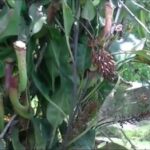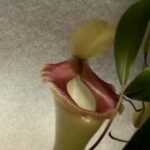As an Amazon Associate, this site earns commissions from qualifying purchases. For more details, click here.
Nepenthes sanguinea is prevalent in many parts of Malaysia and Thailand, and this tropical pitcher plant varies in color from green, red, yellow to orange. Pitcher size ranges from 4 to 12 inches (10-30 cm) and takes little effort to grow. N. sanguinea can be cultivated indoors and outdoors under ideal conditions.
Bright, indirect light and high humidity are required to grow nepenthes sanguinea. The ideal temperature is 65-80 degrees F and the soil must always be moist. This is a tropical pitcher plant and does not go dormant.
Nepenthes Sanguinea Care Sheet
| Soil | 3:1 long fiber sphagnum and orchid bark |
| Water | Never use tap water. Only purified, distilled or rainwater |
| Light | Full indirect light, indoors or outdoors |
| Food | Small bugs, freeze dried bloodworms, fish betta pellets |
| Temperature | 65-80 F (18-26 C) |
| Humidity | 60-80% |
| Dormancy | No |
| Propagation | Stem cutting |
Soil
Use only low nutrient, neutral or lightly acidic soil. Do not put compost or any type of fertilizer in the potting mix. The poorer the soil the better.
The best approach is to start with the soil mix that comes with your nepenthes sanguinea. If the plant does not respond well, try other potting combinations like Perfect Plant Soil.
If this is your first time with carnivorous plants, that goes against everything you know about planting. Nepenthes (just like Venus flytraps, sundews and butterworts) derive their nutrition from insects, not the soil.
A typical potting soil for nepenthes sanguine is 3:1 long fiber sphagnum and orchid bark. If orchid bark is not available, you may use perlite.
Another common nepenthes potting soil mix is vermiculite, perlite and silica sand. The ratio is usually equal parts perlite and vermiculite with a bit of silica sand.
Some growers like to keep things simple and use only pure live sphagnum. You may add some bark chipping as well. Equal mix perlite and peat moss or pumice with sphagnum could work as well.
Pot Container
Most nepenthes sanguinea are shipped in 4-5 inch pots. Repotting is only needed every two years just like with most healthy nepenthes. You can leave the pot on a windowsill or place it in a terrarium.
With most pitcher plants, including nepenthes jamban, a 3-5 inch pot is enough. If you have a fast growing n. sanguinea, a 5 inch pot is probably for the best. A large container provides the roots with room to grow. Healthy pitcher plants can grow quickly and their roots need space. Repot if you notice the plant is getting too large for the container. Just because your nepenthes came in a 3-4 inch pot does not mean you are limited to that.
Water
These plants need lots of water so the soil is constantly moist. Watering from the top with a sprayer is the best method. Water your nepenthes like you would a regular houseplant. Repeat when the soil starts to dry.
Use pure or distilled water. Do not use water with salt or any chemicals or hard minerals. Water as often as needed to keep soil moist but not waterlogged. Do not sit or stand nepenthes sanguinea in water.
You can put a bit of water in the pitchers during hot days. It is not really necessary as nepenthes sanguinea can produce its own liquids. But adding a bit of water may help the plant conserve its resources.
If the soil dries too often and it is really hot, water more often. It may be tempting to use the tray method but that could cause more problems. Some pitcher plants like sarracenia benefit from sitting in water. Most nepenthes do not because their roots are sensitive to rot.
While these plants require water to grow, too much of it can be hazardous to their health. It is better to water from the top frequently rather than risk getting root rot or other diseases from appearing.
Light
For the best results, grow nepenthes sanguinea in full, indirect light. These pitcher plants adapt well to artificial lights as well. You can grow these plants indoors or outside. Each requires a different approach.
Outdoors. Find a spot where the sun shines brightly. Place the pot so that light reaches it indirectly. You have to do the same if you hang pitcher plants.
A nepenthes growing in a terrarium needs LED or Durolux HD T5 Grow Lights. Do not use standard light bulbs because they cannot provide enough intensity. Position the light at least 12-15 inches from the terrarium.
Indoors. You have two options, the windowsill or a terrarium. The easier way is to just set your nepenthes sanguinea on a windowsill. The window provides light but also prevents the sun from directly hitting the plant.
Temperature
The temperature should be 65-80 F (18-26 C). Nepenthes sanguinea can tolerate temperatures down to 50 F (10 C) and up to 95 F (35 C) for short periods.
Temperature plays a key role in the growth and development of these plants. Too high or too low hinders growth and could cause damage.
Healthy nepenthes can withstand changing weather. As long as the temperature is not constantly at 90 F or below 50 F, your nepenthes will survive. But if you want the plant to flourish, you have to grow it as close to 65-80 degrees as possible.
Regardless which you choose, nepenthes needs sunlight and the right temperature. Their pitchers require them and these plants cannot last long without their traps.
If you live in zone 10 or higher, the cold will not be a problem. You can cultivate as many of these as you want outdoors. If your region is prone to cold winters however, a terrarium or indoor growing is the best alternative.
Humidity
Nepenthes sanguinea prefers a sunny, highly humid environment. The level should be at least 60% but 80% or higher is even better.
Humidity levels indicate how much water vapor is in the air. The higher the humidity, the wetter it feels. High humidity is good for nepenthes because it allows soil to retain moisture longer.
A humid environment balances the heat from the sun. The water vapor also helps the plant produce more liquids for its traps. The more traps a pitcher plant produces, the more bugs it can catch.
Carnivorous plants grown in a terrarium need a humidifier. This will balance out the heat inside the container and keep the plant healthy. Combined with a light source and your nepenthes should do well.
Nutrition and Feeding
Nepenthes sanguinea digests small insects including crickets, ladybugs, and flies. They try to avoid eating bees as much as possible because they are pollinators.
Feeding is the simplest part of nepenthes care. If it is outside and catches prey regularly, no help isneeded.
For terrarium based pitcher plants, feed them every two weeks. Apart from insects, you can also use fertilizer like Maxsea. Mix 1/4 teaspoon fertilizer with a gallon of water. Feed your plant every two weeks.
Do not give it too much fertilizer, just the amount stated here. You will see that in a few months or weeks, the plant will grow much more quickly than before. Be ready to repot in case the plant outgrows its container.
If you prefer insects or mealworms, drop them into the pitchers. Do not fill each one as nepenthes sanguinea only needs a small amount of nutrients.
Dormancy
Nepenthes sanguinea is a tropical pitcher plant and does not go dormant. Just like nepenthes lowii, the plant does not have the ability to survive in freezing cold weather.
When a plant goes dormant, it usually forms a hibernacula and remains in that state for the duration of winter. That is the case with some butterworts. Venus flytraps on the other hand, shed their leaves, shrink and look all but dead. Then it comes alive again in spring.
N. sanguinea does not do any of that. It grows continuously throughout the year. For this reason the plant must be kept in a constantly warm location. The temperature and humidity must be in the ideal range and the plant has to have access to nutrition.
Because n. sanguinea does not enter dormancy, you can prune, trim and propagate it anytime. Although for the sake of convenience, most people do these right after dormancy along with other plants.

My fascination with carnivorous plants began many, many years ago with Venus Fly Traps. Now I am more than happy to impart what I know with other enthusiasts and those who are curious about meat eating plants.



